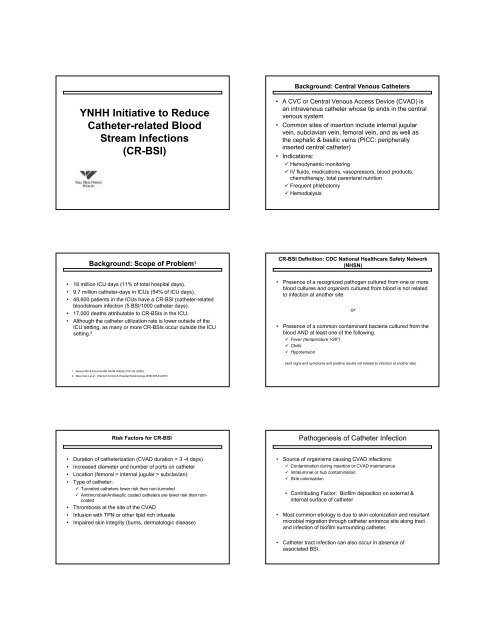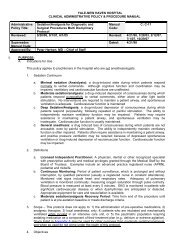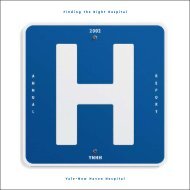Medical Staff Education Reading Materials - Yale-New Haven Hospital
Medical Staff Education Reading Materials - Yale-New Haven Hospital
Medical Staff Education Reading Materials - Yale-New Haven Hospital
You also want an ePaper? Increase the reach of your titles
YUMPU automatically turns print PDFs into web optimized ePapers that Google loves.
YNHH Initiative to Reduce<br />
Catheter-related Blood<br />
Stream Infections<br />
(CR-BSI)<br />
Background: Scope of Problem 1<br />
• 18 million ICU days (11% of total hospital days).<br />
• 9.7 million catheter-days in ICUs (54% of ICU days).<br />
• 48,600 patients in the ICUs have a CR-BSI (catheter-related<br />
bloodstream infection (5 BSI/1000 catheter days).<br />
• 17,000 deaths attributable to CR-BSIs in the ICU.<br />
• Although the catheter utilization rate is lower outside of the<br />
ICU setting, as many or more CR-BSIs occur outside the ICU<br />
setting. 2<br />
1. Wenzel RP & Edmond MB: NEJM 355(26):2781-83 (2006)<br />
2. Marschall J et al. Infection Control & <strong>Hospital</strong> Epidemiology 28(8):905-9 (2007)<br />
Risk Factors for CR-BSI<br />
• Duration of catheterization (CVAD duration > 3 -4 days)<br />
• Increased diameter and number of ports on catheter<br />
• Location (femoral > internal jugular > subclavian)<br />
• Type of catheter:<br />
Tunneled catheters lower risk than non-tunneled<br />
Antimicrobial/Antiseptic coated catheters are lower risk than noncoated<br />
• Thrombosis at the site of the CVAD<br />
• Infusion with TPN or other lipid rich infusate<br />
• Impaired skin integrity (burns, dermatologic disease)<br />
Background: Central Venous Catheters<br />
• A CVC or Central Venous Access Device (CVAD) is<br />
an intravenous catheter whose tip ends in the central<br />
venous system<br />
• Common sites of insertion include internal jugular<br />
vein, subclavian vein, femoral vein, and as well as<br />
the cephalic & basilic veins (PICC: peripherally<br />
inserted central catheter)<br />
• Indications:<br />
Hemodynamic monitoring<br />
IV fluids, medications, vasopressors, blood products,<br />
chemotherapy, total parenteral nutrition<br />
Frequent phlebotomy<br />
Hemodialysis<br />
CR-BSI Definition: CDC National Healthcare Safety Network<br />
(NHSN)<br />
• Presence of a recognized pathogen cultured from one or more<br />
blood cultures and organism cultured from blood is not related<br />
to infection at another site<br />
or<br />
• Presence of a common contaminant bacteria cultured from the<br />
blood AND at least one of the following:<br />
Fever (temperature >38°)<br />
Chills<br />
Hypotension<br />
(and signs and symptoms and positive results not related to infection at another site)<br />
Pathogenesis of Catheter Infection<br />
• Source of organisms causing CVAD infections:<br />
Contamination during insertion or CVAD maintenance<br />
Intraluminal or hub contamination<br />
Skin colonization<br />
• Contributing Factor: Biofilm deposition on external &<br />
internal surface of catheter<br />
• Most common etiology is due to skin colonization and resultant<br />
microbial migration through catheter entrance site along tract<br />
and infection of biofilm surrounding catheter.<br />
• Catheter tract infection can also occur in absence of<br />
associated BSI.






![Annual Report Donor Listings [pdf] - Yale-New Haven Hospital](https://img.yumpu.com/49673575/1/190x245/annual-report-donor-listings-pdf-yale-new-haven-hospital.jpg?quality=85)










